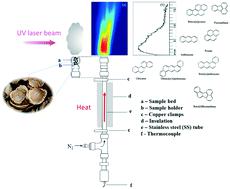当前位置:
X-MOL 学术
›
React. Chem. Eng.
›
论文详情
Our official English website, www.x-mol.net, welcomes your
feedback! (Note: you will need to create a separate account there.)
In situ observation of the evolution of polyaromatic tar precursors in packed-bed biomass pyrolysis
Reaction Chemistry & Engineering ( IF 3.4 ) Pub Date : 2021-5-6 , DOI: 10.1039/d1re00032b Maryanne Chelang'at Mosonik 1 , Roberto Volpe 1 , Chinonso Ezenwajiaku 2 , Midhat Talibi 2 , Ramanarayanan Balachandran 2
Reaction Chemistry & Engineering ( IF 3.4 ) Pub Date : 2021-5-6 , DOI: 10.1039/d1re00032b Maryanne Chelang'at Mosonik 1 , Roberto Volpe 1 , Chinonso Ezenwajiaku 2 , Midhat Talibi 2 , Ramanarayanan Balachandran 2
Affiliation

|
Pyrolysis provides a route for the conversion of lignocellulosic biomass into solid, liquid and gaseous energy vectors or platform chemicals. Polycyclic aromatic hydrocarbons (PAHs) generated in the vapour phase of the biomass pyrolytic reaction may condense to form tars, which are difficult to further upgrade and cause process inefficiency. Control of tar production requires optimization of reactor design and careful control of reactor operating conditions. In this study, a vertical resistively-heated fixed-bed reactor is used to study the effect of pyrolysis peak temperatures and holding period (at peak temperature) on the formation of PAHs during pyrolysis of two lignocellulosic biomass samples, walnut shells (WS) and almond shells (AS). ‘In situ’ planar laser induced fluorescence (PLIF) is used to optically detect 3-to-5 ring PAHs in the vapour phase immediately above the reactor bed. Results show that the PAH PLIF signal appeared at ∼275 °C for the biomass samples and peaked at ∼400 °C for WS and ∼375 °C for AS, which is in agreement with previous ‘off situ’ analysis conducted by the authors. Beyond 400 °C, the PLIF signal was observed to reduce significantly and almost disappear at 550 °C. Initial PAH formation was attributed to condensation reactions occurring due to the drop in temperature along the sample bed. The detection of the PAH PLIF signal itself and its changing intensities, close to the bed, signified the rapid changes the products released from biomass undergo and emphasised the importance of using online techniques for pyrolysis studies. The detailed understanding of the temperature dependent characteristics of PAH formation from this study could help improve reactor design.
中文翻译:

填充床生物质热解过程中聚芳族焦油前体演化的原位观察
热解提供了将木质纤维素生物质转化为固体、液体和气体能量载体或平台化学品的途径。生物质热解反应气相中产生的多环芳烃 (PAH) 可能会冷凝形成焦油,难以进一步升级并导致工艺效率低下。焦油生产的控制需要优化反应器设计和仔细控制反应器操作条件。在本研究中,使用立式电阻加热固定床反应器研究热解峰值温度和保持时间(在峰值温度下)对两种木质纤维素生物质样品、核桃壳 (WS) 和热解过程中 PAHs 形成的影响。杏仁壳(AS)。'就地' 平面激光诱导荧光 (PLIF) 用于光学检测反应器床正上方气相中的 3 到 5 个环多环芳烃。结果表明,生物质样品的 PAH PLIF 信号出现在 ~275 °C 处,WS 的峰值出现在 ~400 °C,AS 的峰值出现在 ~375 °C,这与之前的“非原位”一致' 作者进行的分析。超过 400°C,观察到 PLIF 信号显着降低,在 550°C 时几乎消失。最初的 PAH 形成归因于由于沿样品床的温度下降而发生的缩合反应。PAH PLIF 信号本身及其变化强度的检测,靠近床层,表明生物质释放的产品经历了快速变化,并强调了使用在线技术进行热解研究的重要性。这项研究对PAH形成过程的温度依赖性特征的详细了解可以帮助改进反应堆的设计。
更新日期:2021-05-30
中文翻译:

填充床生物质热解过程中聚芳族焦油前体演化的原位观察
热解提供了将木质纤维素生物质转化为固体、液体和气体能量载体或平台化学品的途径。生物质热解反应气相中产生的多环芳烃 (PAH) 可能会冷凝形成焦油,难以进一步升级并导致工艺效率低下。焦油生产的控制需要优化反应器设计和仔细控制反应器操作条件。在本研究中,使用立式电阻加热固定床反应器研究热解峰值温度和保持时间(在峰值温度下)对两种木质纤维素生物质样品、核桃壳 (WS) 和热解过程中 PAHs 形成的影响。杏仁壳(AS)。'就地' 平面激光诱导荧光 (PLIF) 用于光学检测反应器床正上方气相中的 3 到 5 个环多环芳烃。结果表明,生物质样品的 PAH PLIF 信号出现在 ~275 °C 处,WS 的峰值出现在 ~400 °C,AS 的峰值出现在 ~375 °C,这与之前的“非原位”一致' 作者进行的分析。超过 400°C,观察到 PLIF 信号显着降低,在 550°C 时几乎消失。最初的 PAH 形成归因于由于沿样品床的温度下降而发生的缩合反应。PAH PLIF 信号本身及其变化强度的检测,靠近床层,表明生物质释放的产品经历了快速变化,并强调了使用在线技术进行热解研究的重要性。这项研究对PAH形成过程的温度依赖性特征的详细了解可以帮助改进反应堆的设计。











































 京公网安备 11010802027423号
京公网安备 11010802027423号